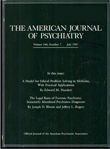Small planum temporale volume in Down's syndrome: a volumetric MRI study
Abstract
OBJECTIVE: Down's syndrome is associated with structural brain abnormalities and language deficits. The aim of this study was to investigate whether the superior temporal gyrus and the planum temporale, both parts of the anatomic substrate for language, are abnormal in Down's syndrome. METHOD: The authors examined volumetric magnetic resonance imaging (MRI) measures of the superior temporal gyrus and the planum temporale for 17 community-dwelling patients with Down's syndrome and 17 matched healthy comparison subjects. For the subjects with Down's syndrome, the correlations of the superior temporal gyrus and planum temporale volumes with performance on tests of language function were examined. RESULTS: The planum temporale volume of the patients with Down's syndrome was smaller than that of the healthy subjects, even after differences in whole brain volume were controlled for. The volume of the superior temporal gyrus in the Down's syndrome patients was proportionally similar to that of the comparison group. For the subjects with Down's syndrome, neither superior temporal gyrus nor planum temporale volume was significantly correlated with performance on language tests after total brain volume was controlled for. CONCLUSIONS: In Down's syndrome, planum temporale volume may be selectively smaller than normal, although the effect of this volume deficit on language is not clear.



